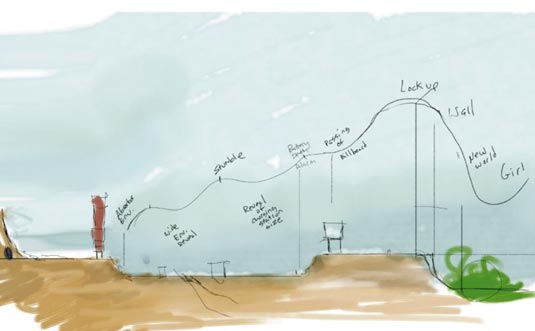Real-time animated short shows the power of facial capture technology
Check out this real-time interactive animated short from the Mixamo team to showcase its Face Plus technology.
Taking viewers through the story of a boy breaking free from a meaningless and dreary life, Unplugged demonstrates the kind of quality that anyone can now achieve with Face Plus, a webcam and a creative concept.
How did the film come about?
The initial idea was to create a real-time animated short that leveraged Unity 3D's new blendshape support and Mixamo's new technology for facial animation, Face Plus. Rather than create a demo, we decided to tell a story using an animated short, which meant we focused a lot on story creation and character development.
We drew on other works for inspiration, especially Premier Automne by Carlos de Carvalho. Style-wise, we wanted to create something with a 2D painted look, and get away from the 3D shaded look. This was a stylistic decision and a way to create a more surreal, dream-like world.

Did Unplugged take long to produce?
It took about ten weeks. We had James Zachary directing it as we thought having such a great animation talent (former lead animator at LucasArt) was very important for an animation focused short. At peak twelve people worked on it. The short was designed to run in the Unity 3D engine in real-time, which required some coding but no rendering time. That ultimately saved us a lot of time on production.

What 3D software did you use?
We used Maya and ZBrush for modelling and texturing, and MotionBuilder for real-time previsualisation, mocap and animation. Having our own internal mocap studio allowed us to put together a rough previs of the whole short in just a couple of days, so we could iterate more quickly.
We used Mixamo Face Plus for the facial animation motion capture both in MotionBuilder and Unity to get a feel in real time of what the performance would look like in the engine. It was a lot of fun to play with it and see what the different motion capture actors were able to get out of it. And we used Maya to add the final tweaks and secondary animations.

We choose Unity 3D to render and develop the short as we believe the world is shifting towards more real-time and interactive ways to create film and video content in general. We also collaborated with Unity and AMD.
Daily design news, reviews, how-tos and more, as picked by the editors.
Did you learn anything in making this?
The main difficulty we experienced was in trying to create a high-quality environment, specifically the terrain. The set is a desert-like environment and it was hard to get the quality of the mesh and texture we wanted, and keep it within the memory constraints of the engine to make sure everything still played in real time.
We spent an extra week optimising the assets, which is far less creative, but important nevertheless. My humble advice is – when possible – to always think about the technical ramifications of the story in pre-production to prevent any redesign of the assets in the later stages of the production, while at the same time keeping the integrity of the story.
What's next for you?
We hope we will have the opportunity to produce more animated content like this in the future. There's nothing more exciting than a blank slate with a budget number and a deadline attached to it!
Words: Stefano Corazza
Stanford graduate Stefano Corazza is the executive producer/ experimental designer of Unplugged and the mastermind behind Mixamo's 3D character creation technology. This article originally appeared in 3D World issue 183.

The Creative Bloq team is made up of a group of art and design enthusiasts, and has changed and evolved since Creative Bloq began back in 2012. The current website team consists of eight full-time members of staff: Editor Georgia Coggan, Deputy Editor Rosie Hilder, Ecommerce Editor Beren Neale, Senior News Editor Daniel Piper, Editor, Digital Art and 3D Ian Dean, Tech Reviews Editor Erlingur Einarsson, Ecommerce Writer Beth Nicholls and Staff Writer Natalie Fear, as well as a roster of freelancers from around the world. The ImagineFX magazine team also pitch in, ensuring that content from leading digital art publication ImagineFX is represented on Creative Bloq.

